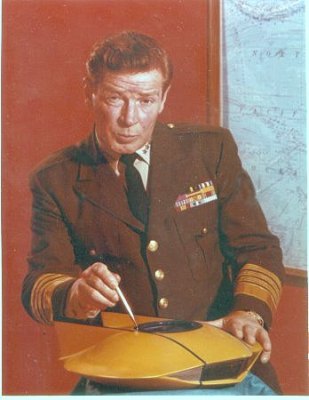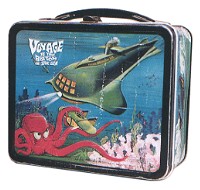| Reviews & Columns |
|
Reviews DVD TV on DVD Blu-ray 4K UHD International DVDs In Theaters Reviews by Studio Video Games Features Collector Series DVDs Easter Egg Database Interviews DVD Talk Radio Feature Articles Columns Anime Talk DVD Savant Horror DVDs The M.O.D. Squad Art House HD Talk Silent DVD
|
DVD Talk Forum |
|
|
| Resources |
|
DVD Price Search Customer Service #'s RCE Info Links |
|
Columns
|
|
|
Voyage to the Bottom of Sea (Season Two, Volume Two)
Star Richard Basehart feeling that ulcer kicking in near the end of Voyage to the Bottom of the Sea's second season.
As before, Voyage is set roughly ten years into the near future and aboard the Seaview, Admiral Harriman Nelson's (Richard Basehart) fantastic submarine. Captained by Nelson's best friend and surrogate son, Lee Crane (David Hedison), the pair fight a never-ending battle against strange (and usually gigantic) sea creatures, nefarious Communist spies, pirates (yes, pirates), Blofeld-like super-villains and the like. Also aboard are Lt. Commander Chip Morton (Robert Dowdell), seamen Kowalski (Del Monroe) and Stuart Riley (Allan Hunt), and Chief Sharkey (Terry Becker).
While there are only so many stories you can do aboard a submarine, all of Irwin Allen's shows have notably weak scripts that favor unscientific fantasy and stock action-adventure cliches over intelligent, character-driven drama and thought-provoking science fiction. This was especially true on The Time Tunnel, which almost never explored the myriad possibilities and ramifications of time travel itself (as was frequently being done on other concurrent shows like Star Trek and Doctor Who), opting instead for a rigid escape-recapture formula harking back to movie serials, where only the costumes and stock footage changed every week.
On Voyage to the Bottom of the Sea, the big problem was that Allen recycled the same six or seven basic plots over-and-over again. A "brilliant" (according to Nelson) but "reckless" (according to Crane) and obsessed scientist invents/discovers something, putting the Seaview - and often the entire planet - in danger. Nelson or Crane is brainwashed / altered / replaced by communist spies and, in his altered state, tries to kill the other. The Seaview is menaced by some big monster, or Nelson and/or Crane are stranded on some island. You know the show's running out of ideas when the Flying Sub, introduced with great fanfare at the beginning of the season, is destroyed three times before the year was out, twice at the beginning of each of the first two episodes in this set!
Also discouraging is Allen's use of stock footage, both from his own movies and earlier Voyage episodes, as well as from other 20th Century-Fox films (The Enemy Below, etc.), all in an effort to save money. The set opens with a show called "Terror on Dinosaur Island," which uses scenes from Allen's The Lost World (1960) which had already been mined for the first season show "Turn Back the Clock." Another show, "The Sky's On Fire," is essentially a remake of Allen's 1961 feature version of Voyage to the Bottom of the Sea and uses scads of stock shots from that film. "The Shape of Doom" even uses black and white footage, tinted here, from season one!
Cheapness aside, the show is still a feast for the eyes, especially the wonderful miniature effects credited to L.B. Abbott and Howard Lydecker.
Near the end of the first season, actor Henry Kulky, who played Chief Curly Jones on the show, suddenly dropped dead of a heart attack. In the series, the character simply vanished without a trace; no mention was ever made of his absence and probably few people watching the show even noticed that he was gone. A year later star Richard Basehart suddenly fell ill, officially the result of a bleeding ulcer, and had to drop out of three shows, one apparently already midway through production with two at the ready.
In "The Monster's Web" (featuring a lively and hairy giant sea spider) Basehart's character is in some scenes, conspicuously absent in others, and badly doubled here and there by a stand-in wrapped in bandages. The show must have driven guest star Peter Mark Richman crazy: with Basehart M.I.A., it looks like Richman's part was beefed up, with the familiar character actor taking over several of Basehart's scenes. This would be fine except Basehart's Nelson is cautious and heroic, while Richman's is supposed to be reckless and obsessive, so in the final cut of the show Richman's character comes off hopelessly schizophrenic. Gary Merrill (All About Eve) pinch-hit for Basehart as visiting Admiral Park in the next episode, while the third show without Basehart rearranged dialogue so that Hedison more or less got Nelson's part while Dowdell reads lines originally intended for Capt. Crane.
Guest stars in this set include Michael Ansara, Patrick Wayne, Nehemiah Persoff, Alfred Ryder, Robert H. Harris, Robert Loggia, James Darren, Albert Salmi, Ross Elliott, Vic Lundin, Seymour Cassel, Vitina Marcus, and Richard Bull. Most of the shows were written and/or directed by journeymen-to-hack scribes and helmers long associated with Allen: Nathan Juran, Sobey Martin, Peter Parker, etc. One show is directed by rising talent Tom Gries.
Video & Audio
Voyage to the Bottom of the Sea - Season Two, Volume Two presents the second-half of the second season, thirteen 50-minute episodes in all, on three double-sided discs. Four shows are included on side A of the first disc; subsequent sides have two episodes except for side B of the third disc, which has one show plus the extra features. The shows look great, with rich color, a sharp, clean image with little signs of age and wear. The shows are not edited or time-compressed and this reviewer experienced no problems playing the discs. Episodes are offered in both their original 1.0 mono and a Dolby Digital 2.0 "stereo" remix. A Spanish mono track is included, as well as optional English and Spanish subtitles, though nothing in French.
Extra Features
There's more of the David Hedison Interview, running six minutes, in which the still-handsome actor maintains a good sense of humor about the show and is honest about its shortcomings. Though he liked Allen personally Hedison says, frankly, "I think he ruined it," noting by the last season or two the series had become "ludicrous."
A Still Gallery includes photos of the miniatures, episodic photos (again, many are actually from Season 1), and publicity photos.
Parting Thoughts
Voyage to the Bottom of the Sea - Season Two, Volume Two is sometimes exciting, more frequently goofy escapist fun. The show was by this point in decline, but still enjoyable, and Fox's DVD shows it off in all its primary colored-glory. Recommended.
Stuart Galbraith IV is a Kyoto-based film historian whose work includes Monsters Are Attacking Tokyo! The Incredible World of Japanese Fantasy Films and Taschen's forthcoming Cinema Nippon, due out this year.
|
| Popular Reviews |
| Sponsored Links |
|
|
| Sponsored Links |
|
|
| Release List | Reviews | Shop | Newsletter | Forum | DVD Giveaways | Blu-Ray | Advertise |
|
Copyright 2024 DVDTalk.com All Rights Reserved. Legal Info, Privacy Policy, Terms of Use,
Manage Preferences,
Your Privacy Choices | |||||||
















